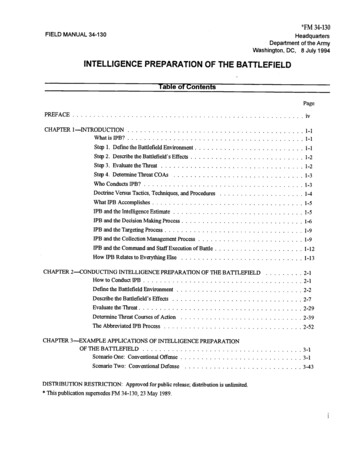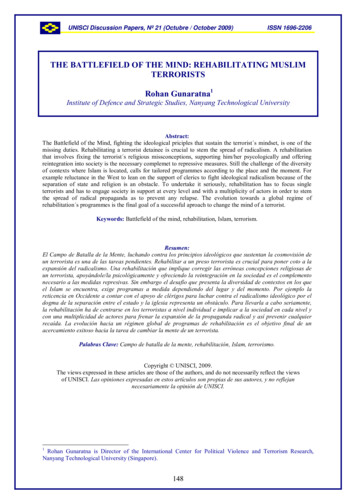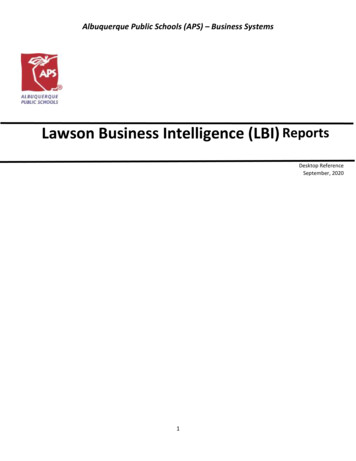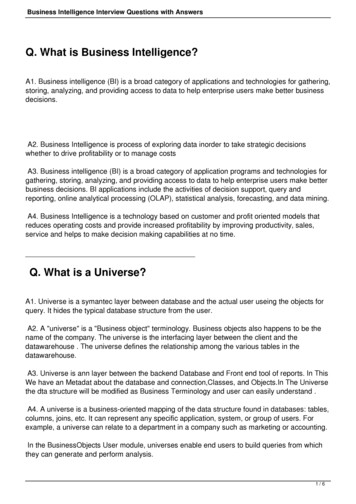
Transcription
*FM 34-130i
FM 34-130ii
FM 34-130iii
FM 34-130PrefaceThe purpose of this manual is to describe the fundamentals of intelligencepreparation of the battlefield (IPB). It describes IPB, its use in directing theintelligence effort, and its role in driving the staff’s planning for contingencey orcombat operations. It prescribes the procedures followed in performing IPBand illustrates the application of IPB in various situations.This manual is intended to serve as a guide for the use of IPB by units of alltypes, at all echelons, across the entire spectrum of conflict, and during theconduct of any mission. It does not contain all the data required to conductIPB, such as specific information on threat doctrine or equipment capabilities.Rather, it is intended as a guide for applying the fundamentals of the IPBprocess to any situation.No part of this document should be construed as limiting commanders’freedom of action or committing commanders to a fixed or particular course ofaction (COA). Nor should it be construed to imply that all IPB products mustbe prepared by all commands in all situations. Commanders should apply thedoctrine and information presented in this manual in any manner appropriate totheir particular situation and mission.This manual is intended for Army commanders and staffs at all echelons. Itapplies equally to the Active Component (AC), United States Army Reserve(USAR), and Army National Guard (ARNG). It is also intended to be of use tocommanders and staffs of joint and combined commands; Marine and Navalforces; units of the Air Force; and the military forces of allied countries.This field manual is printed in multicolors to clearly portray the IPB process.This color is unique to this manual and is not to be confused or related to thecolor keys normally associated with standard topographical symbols.This manual does not implement any International StandardizationAgreements.Unless this publication states otherwise, masculine nouns and pronouns donot refer exclusively to men.The proponent of this publication is the United States Army IntelligenceCenter and Fort Huachuca, Fort Huachuca, AZ. Send comments andrecommendations on DA Form 2028 (Recommended Changes to Publicationsand Blank Forms) directly to Commander, US Army Intelligence Center andFort Huachuca, ATTN: ATZS-TDL-D, Fort Huachuca, AZ 85613-6000.Upon revision, this manual will be dual designated with the US MarineCorps as FM 34-130/FMFM 3-20-1.iv
FM 34-130CHAPTER 1INTRODUCTIONIf I always appear prepared, it is because before entering on anundertaking, I have meditated for long and foreseen what may occur.— Napoleon Bonaparte, 1831IPB is the best process we have for understanding the battlefield and the options it presents tofriendly and threat forces.What is IPB?IPB is a systematic, continuous process of analyzing the threat and environment in a specificgeographic area. It is designed to support staff estimates and military decision making.Applying the IPB process helps the commander selectively apply and maximize his combatpower at critical points in time and space on the battlefield by—Determining the threat’s likely COA.Describing the environment your unit is operating within and the effects of theenvironment on your unit.IPB is a continuous process which consists of four steps which you perform each time youconduct IPB:Define the battlefield environment.Describe the battlefield’s effects.Evaluate the threat.Determine threat COAs.The IPB process is continuous. You conduct IPB prior to and during the command’s initialplanning for an operation, but you also continue to perform IPB during the conduct of theoperation. Each function in the process is performed continuously to ensure that—The products of IPB remain complete and valid.You provide support to the commander and direction to the intelligence systemthroughout the current mission and into preparation for the next.A brief overview of each function is presented below. For a thorough discussion, seeChapter 2.Step 1. Define the Battlefield EnvironmentIn step 1 of the IPB process, the G2/S2—Identifies characteristics of the battlefield which will influence friendly and threatoperations.Establishes the limits of the area of interest (AI).Identifies gaps in current intelligence holdings.This focuses the command’s initial intelligence collection efforts and the remaining steps ofthe IPB process.1-1
FM 34-130To focus the remainder of the IPB process, the G2/S2 identities characteristics of thebattlefield which require in-depth evaluation of their effects on friendly and threat operations,such as terrain, weather, logistical infrastructure, and demographics. Generally, these areanalyzed in more detail for areas within the command’s area of operations (AO) and battlespace than for other areas in the AI.The G2/S2 establishes the limits of the AI to focus analytical and intelligence collectionefforts on the geographic areas of significance to the command’s mission. He bases the AI’slimits on the amount of time estimated to complete the command’s mission and the locationand nature of the characteristics of the battlefield which will influence the operation. If thecommand has not been assigned an AO, the G2/S2 coordinates with the G3/S3 to develop ajoint recommendation on its limits for the commander’s approval. Similarly, the G2/S2confers with the G3/S3 on recommendations for the command’s battle space duringdevelopment of friendly COAs.Defining the significant characteristics of the battlefield environment also aids in identifyinggaps in current intelligence holdings and the specific intelligence required to fill them.Similarly, the G2/S2 identifies gaps in the command’s knowledge of the threat and thecurrent threat situation.Once approved by the commander, the specific intelligence required to fill gaps in thecommand’s knowledge of the battlefield environment and threat situation becomes thecommand’s initial intelligence requirements.Step 2. Describe the Battlefield’s EffectsStep 2 evaluates the effects of the environment with which both sides must contend. TheG2/S2 identifies the limitations and opportunities the environment offers on the potentialoperations of friendly and threat forces. This evaluation focuses on the general capabilitiesof each force until COAs are developed in later steps of the IPB process.This assessment of the environment always includes an examination of terrain and weatherbut may also include discussions of the characteristics of geography and infrastructure andtheir effects on friendly and threat operations.Characteristics of geography include general characteristics of the terrain and weather, aswell as such factors as politics, civilian press, local population, and demographics. Anarea’s infrastructure consists of the facilities, equipment, and framework needed for thefunctioning of systems, cities, or regions. Products developed in this step might include, butare not limited to—Population status overlay.Overlays that depict the military aspects and effects of terrain.Weather analysis matrix.Integrated products such as modified combined obstacle overlays (MCOOs).Regardless of the subject or means of presentation, the G2/S2 ensures that these productsfocus on the effects of the battlefield environment.Step 3. Evaluate the ThreatIn step 3, the G2/S2 and his staff analyze the command’s intelligence holdings to determinehow the threat normally organizes for combat and conducts operations under similar1-2
FM 34-130circumstances. When facing a well-known threat, the G2/S2 can rely on his historical databases and well developed threat models. When operating against a new or less well-knownthreat, he may need to develop his intelligence data bases and threat models concurrently.The G2/S2’s evaluation is portrayed in a threat model that includes doctrinal templates whichdepict how the threat operates when unconstrained by the effects of the battlefieldenvironment. Although they usually emphasize graphic depictions (doctrinal templates),threat models sometimes emphasize matrices or simple narratives.Step 4. Determine Threat COAsStep 4 integrates the results of the previous steps into a meaningful conclusion. Given whatthe threat normally prefers to do, and the effects of the specific environment in which he isoperating now, what are his likely objectives and the COAs available to him? In step 4, theG2/S2 develops enemy COA models that depict the threat’s available COAs. He alsoprepares event templates and matrices that focus intelligence collection on identifying whichCOA the threat will execute.The enemy COA models developed in step 4 are the products that the staff will use to portraythe threat in the decision making and targeting processes. The G2/S2 cannot produce thesemodels, effectively predicting the threat COAs, unless he has—Adequately analyzed the friendly mission throughout the time duration of the operation;identified the physical limits of the AO and AI; and identified every characteristic of thebattlefield environment that might affect the operation (step 1).Identified the opportunities and constraints the battlefield environment offers to threatand friendly forces (step 2).Thoroughly considered what the threat is capable of and what he prefers to do in likesituations if unconstrained by the battlefield environment (step 3).In short, the enemy COA models which drive the decision making process are valid only ifthe G2/S2 establishes a good foundation during the first three steps of the IPB process.Who Conducts IPB?Everyone in the US Army conducts some form of IPB. For example:A rifleman in an infantry fire team considers the possible actions of the enemy soldierhe is about to engage. He also considers how the local terrain and weather affect bothhimself and his adversary.An armor company commander considers the possible actions of the enemy battalionthat he is about to engage. He also considers how terrain affects the enemy’s COAsand the accomplishment of his own mission.Both of these examples illustrate an informal application of IPB; that is, describe the effectsof the battlefield and determine the threat’s COAs. It is the application of battlefieldcommon sense. At this level it requires little formal education beyond realistic field trainingexercises (FTXs) against a “savvy” enemy.As the size of the unit increases, the level of detail required in the IPB effort increasessignificantly. An armored company commander’s informal IPB produces little more than anappreciation of what the threat is most likely to do during their engagement. A divisionstaffs IPB can produce—1-3
FM 34-130Detailed terrain analysis products.Climatic summaries.Detailed studies of the threat, his equipment, and his doctrine.A comprehensive set of enemy COA models depicting a broad range of possible threatCOAs.Any unit large enough to have a staff (S1, S2, S3, and S4) develops at least some of theformal IPB products described in this manual. The G2/S2 has staff responsibility for thecommand’s IPB--that IPB which directly supports the decision making process. The G2/S2,however, is not the only one who conducts or needs to understand and use IPB.Every commander and every member of the staff needs to understand and apply IPBduring the staff planning process. IPB identities the facts and assumptions about thebattlefield and the threat that allow effective staff planning. IPB forms the basis for definingthe COAs available to the friendly command and drives the wargaming process that selectsand refines them.The G2/S2 is responsible for facilitating the unit IPB effort, but he and his staff cannotprovide all the IPB the unit requires. Every commander and staff officer needs to thinkthrough the effects the environment has on both threat and friendly operations.Furthermore, every staff officer should prepare detailed IPB products tailored for his ownfunctional area. For example:A division electronic warfare (EW) officer will expand and refine the divisionall-source production sect ion’s (ASPS) IPB products to include electronic preparation ofthe battlefield.The engineer liaison for a brigade staff refines and customizes the S2’s enemy COAmodels to show threat options for the employment of obstacles or breaching equipment.The counterintelligence analysis section (CIAS) refines the ASPS’s IPB products tofocus on the threat’s intelligence system and its collection capabilities.A division air defense artillery (ADA) officer uses the ASPS’s IPB products as the basisfor developing enemy air COA models and supporting event templates and matrices.Staff officers in the support operations section refine the ASPS’s IPB products to focuson the logistics support mission and prepare IPB products for their specific functionalareas.The chemical staff officer refines the ASPS’s enemy COA models to show the enemy’soptions for employing nuclear, biological, and chemical (NBC) weapons. This allowsrefinement of the NBC reconnaissance support plan and enhances contaminationavoidance tactics and techniques.The bottom line is that every soldier conducts IPB. Every soldier thinks through an informalIPB procedure, but commanders and staff officers undertake a more formal process.Doctrine Versus Tactics, Techniques, and ProceduresThe doctrinal principles of IPB are sound and can be applied to all situations at all levels.The tactics, techniques, and procedures (TTP) of applying IPB may vary according to themission, enemy, terrain, troops, and time available (METT-T) situation.1-4
FM 34-130The doctrinal principles of IPB call for—Evaluating the battlefield’s effects on friendly and threat operations.Determining the threat’s possible COAs and arranging them in order of probability ofadoption.Identifying assets the threat needs to make each COA successful (high value targets[HVTs]) and where they can be expected to appear on the battlefield (target areas ofinterest [TAIs]).Identifying the activities, or lack of, and the locations where they will occur that willidentify which COA the threat has adopted.The decision to use a sketch instead of an overlay to depict the battlefield’s effects or thethreat’s available COAs is a matter of TTP. Such decisions can only be made within thecontext of a given situation. Similarly, the amount of detail that goes into each step of theIPB process, the techniques for depicting areas of RESTRICTED terrain, and other suchdecisions are also driven by factors of METT-T and local policies and procedures.What IPB AccomplishesIPB identifies facts and assumptions about the battlefield environment and the threat. Thisenables staff planning and the development of friendly COAs.IPB provides the basis for intelligence direction and synchronization that supports thecommand’s chosen COA.IPB contributes to complete staff synchronization and the successful completion of severalother staff processes, which are described below.IPB and the Intelligence EstimateIn order to facilitate staff planning, the G2/S2 prepares the intelligence estimate before theremainder of the staff complete their own estimates if at all possible. The intelligenceestimate forms the basis for the facts and assumptions of the decision making process,driving the other staff estimates and the remaining steps in the decision making process. Theproducts of IPB are the basis of the intelligence estimate. In fact, if the G2/S2 lacks the timerequired to prepare a written estimate, he can usually substitute graphics that depict theresults of his IPB evaluations and analysis.Paragraph 1, MISSION, of the intelligence estimate restates the command’s mission.Paragraph 2, AREA OF OPERATIONS, which is derived from step 2 of the IPB process,describes the battlefield’s effects. The most important subparagraphs of paragraph 2 are the“effects on enemy COAs” and “effects on own COAs.” These sections describe thebattlefield’s impact on operations.Paragraph 3, ENEMY SITUATION, is derived from step 3 of the IPB process, evaluatethe threat. This is primarily a discussion of what is known about the threat (facts) and theresults of analysis of those facts (assumptions).Paragraph 4, ENEMY CAPABILITIES, is derived from step 4 of the IPB process,determine threat COAs. This is a listing and discussion of the COAs available to thethreat. These COAs should exactly correspond with the enemy COA models developed instep 4 of the IPB process.1-5
FM 34-130Paragraph 5, CONCLUSIONS, is derived from the evaluations made during the IPBprocess. Here you summarize the effects of the battlefield environment on friendly andenemy COAs, list the set of probable threat COAs (in order of probability of adoption), andlist the threat’s exploitable vulnerabilities.IPB and the Decision Making ProcessCommanders and staffs use the decision making process to select a COA and develop anoperations plan (OPLAN), operations order (OPORD), or fragmentary order (FRAGO) thatimplements it. The results and products of IPB, conveyed in the intelligence estimate, areessential elements of the decision making process. Accordingly, the major IPB effort occursbefore and during the first of five steps in the decision making process.The decision making process is a dynamic and continuous process. The staff continues toestimate the situation as the operation progresses, adapting the command’s COA tounforeseen changes in the situation. The IPB which supports the decision making processmust also remain dynamic, constantly integrating new information into the initial set of factsand assumptions.The relationship of the IPB process to each step in the decision making process is discussedbelow (see Figure 1-1).Mission Analysis:In this step IPB products enable the commander to assess facts about the battlefield and makeassumptions about how friendly and threat forces will interact on the battlefield.The description of the battlefield’s effects identifies constraints on potential friendly COAsand may reveal implied missions. It also identifies opportunities the battlefield environmentpresents, such as avenues of approach, engagement areas, and zones of entry, which the staffintegrates into potential friendly COAs and their staff estimates.Enemy capabilities and vulnerabilities identified during evaluation of the threat allow thecommander and staff to make assumptions about the relative capabilities of the friendlycommand. Threat evaluation also provides the detailed information on the threat’s currentdispositions, recent activities, equipment, and organizational capabilities the staff needs tocomplete their own staff estimates and planning.Enemy COA models developed in step 4 of the IPB process, Determine Threat COAs,provide a basis for formulating potential friendly COAs and complete the intelligenceestimate.The IPB process identifies any critical gaps in the command’s knowledge of the battlefieldenvironment or threat situation. As part of his initial planning guidance, the commander usesthese gaps as a guide to establish his initial intelligence requirements.Develop Courses of Action:The staff develops friendly COAs based on the facts and assumptions identified during IPBand mission analysis. Incorporating the results of IPB into COA development ensures thateach friendly COA takes advantage of the opportunities the environment and threat situationoffer and is valid in terms of what they will allow.Analyze and Compare COAs:During the wargaming session the staff “fights” the set of threat COAs, developed in step 4of the IPB process, against each potential friendly COA. Targeting conferences follow or1-6
FM 34-130accompany the wargaming session to refine selected HVTs from the enemy COA models intohigh-payoff targets (HPTs) that support the friendly COA. Figure 1-2 shows this wargaming.Based on the results of wargaming, for each potential friendly COA, the staff—Constructs a decision support template (DST) and its associated synchronization matrix.Identities supporting intelligence requirements.Refines the enemy COA models and event templates and matrices, focusing on theintelligence required to execute the friendly COA.Arranges the threat COAs in order of probability of adoption. (There may be adifferent order of probability for each potential friendly COA.)Identifies the most dangerous threat COA.1-7
FM 34-130Refines the friendly COA, to include identifying the need for branches and sequels.Determines the probability of success of the friendly COA.The results of wargaming each potential friendly COA against the set of enemy COA modelsallows the staff to make a recommendation on the best friendly COA. The G2/S2’srecommendation includes an evaluation of the intelligence system’s ability to provide theintelligence needed to support each COA.Appendix A discusses in more detail the relationship between IPB and wargaming.Decision:Execution:1-8Following staff recommendations, the commander decides upon a COA and issuesimplementing orders. He also approves the list of intelligence requirements associated withthat COA and identities the most important as priority intelligence requirements (PIR). Thecommand’s collection manager uses the results of IPB to develop and implement a collectionplan that will satisfy these requirements (see IPB and the Collection Management Process).As intelligence confirms or denies planning assumptions on the battlefield environment or thethreat’s COA, a continuous IPB process identifies new intelligence requirements. As thebattle progresses, IPB is used to continuously evaluate the situation facing the command,driving new iterations of the decision making process and the directing step of theintelligence cycle.For a complete discussion of the decision making process, see FM 101-5.
FM 34-130IPB and the Targeting ProcessThe targeting process results in targeting guidance that supports the command’s COA. Thisguidance generates additional intelligence requirements in support of each potential friendlyCOA the targeting process supports.Decide:Detect:Deliver:As part of COA analysis and comparison, or immediately after, the staff generally starts thetargeting process with a targeting conference. Using the results of staff wargaming and IPBas a guide, they decide—What targets to acquire and attack (HPTs).What target selection standards (accuracy and timeliness) to use.Where and when these targets will likely be found (named area of interest [NAI] andTAI).How to attack the targets, based on the commander’s targeting concept.Whether battle damage assessment (BDA) on each target is required to support thecommander’s intent or the command’s COA, and how detailed it must be.The targeting team further refines the event templates and matrices to include the informationrequired to support targeting. Figure 1-3 shows an example attack guidance matrix.During this step the command’s collection manager develops collection strategies that willsatisfy specific information requirements which support the targeting process. He plans forsynchronized collection, focusing on the proper HPT at each phase in the command’s COA.If BDA is required to support the command’s COA, the collection manager plans collectionto satisfy that set of requirements as well. Whenever possible, he plans and arranges directdissemination of targeting intelligence from the collector to the targeting cell or appropriatetire support element (FSE).IPB structures the analysis that enables the G2/S2 to advise the commander and fire supportofficer (FSO) on the execution of the tire support plan.For a complete discussion of the targeting process, see FM 6-20-10.IPB and the Collection Management ProcessCollection management synchronizes the activities of organizations and systems to provideintelligence the commander needs to accomplish his COA and targeting efforts. IPB helpsthe commander identify his intelligence requirements and provides the focus and directionneeded to satisfy them.The commander bases his initial intelligence requirements on the critical gaps identifiedduring IPB in the mission analysis step of the decision making process. Refined and updatedrequirements result from staff wargaming and selection of a particular friendly COA.During staff wargaming, the G2/S2 uses the enemy COA models developed in step 4 of theIPB process to portray the enemy. The remainder of the staff “fights” each potential friendlyCOA and notes where and when in its execution decisions are required to make the COAsuccessful. They also determine the specific intelligence required to support each decision1-9
FM 34-130and record it onto the list of proposed intelligence requirements. When the commanderselects a particular friendly COA, he also approves and prioritizes the supporting intelligencerequirements.IPB supports further development of requirements by identifying the activity which willsatisfy each requirement and where and when the activity is expected to occur. The eventtemplate identities the NAI where the activity will occur. The event matrix describes theindicators associated with the activity. Both the event template and event matrix depict thetimes during which the activity is expected to occur. The details these tools provide are thebasis of an effective intelligence collection plan.1-10
FM 34-130IPB products also contribute to the development of staff synchronization tools such as theDST and battlefield operating system (BOS) synchronization matrix, shown in Figure 1-4.The collection manager uses these additional tools to ensure that the collection plan stayssynchronized with the command’s operations. The resulting intelligence synchronizationmatrix (ISM), as shown in Figure 1-5, depicts the collection strategies which support thecommand’s COA.Intelligence synchronization is more than simply ensuring that collection systems of varioussorts are operating 24 hours a day. The G2/S2 must direct the intelligence system, receivethe information it produces, process it and then produce and disseminate intelligence of valueto the commander in time to support his decisions. The coordination of this entire cycle isintelligence synchronization.FM 34-2 discusses intelligence synchronization and the collection management process indetail.1-11
FM 34-130IPB and the Command and Staff Execution of BattleIPB provides the G2/S2 the tools he needs to quickly evaluate incoming information andintelligence as it relates to the command’s ISM and DST. This supports the commander’sdecisions during COA execution and helps him to quickly confirm or deny the assumptionsused during COA development.During battle, the commander and staff track the DST and the ISM against incoming reports.As the staff nears each decision point (DP), they look to the G2/S2 for the intelligence thatsupports that decision.Sometimes the battle will progress in a direction unanticipated during the initial IPB andwargaming. The enemy is following his own plans and timelines; those determined duringstaff wargaming are only estimates. Therefore, staffs should ensure they use IPB,wargaming, and intelligence synchronization as dynamic tools rather than as one-time events.As the operation unfolds and the enemy’s intentions become more clear, reinitiate the IPBand decision making processes as needed. This requires key members of the staff to“huddle” or conduct “mini-wargaming.” During these sessions, the G2/S2 reviews andmodifies the initial IPB. The battle staff then wargames the best friendly response orpreemptive action based on the updated set of IPB predictions. New decisions and COAslead to updating and refining the collection plan, intelligence synchronization, and newdecision support tools.1-12
FM 34-130How IPB Relates to Everything ElseIPB is an essential element of the intelligence cycle. The products developed during IPB areso critical to this cycle and the staff planning effort that it is a distinct function. There aresix intelligence and electronic warfare (IEW) tasks described in FM 34-1, the Army’sintelligence principles manual. They are to develop—IPB products.Situation development products.Indications and warnings (I&W) products.Target development and target acquisition products.BDA products.Force protection products.These IEW functions are accomplished within the Intelligence System of Systems (ISOS) torespond to the commander’s intelligence needs. The ISOS is the flexible architecture ofprocedures, organizations, and equipment that collect, process, store, and disseminateintelligence. The G2/S2 uses IPB products to process volumes of information provided bythe ISOS and the intelligence cycle.IPB products also enable staffs to exploit the modem technology of the ISOS by focusingcollection systems that now provide near-red-time (NRT) information in sufficient accuracyto conduct direct targeting. IPB not only enables a staff to put steel on target but also helpsprioritize and maximize the effects of targeting. IPB plays a critical role in the decisionmaking process. Finally, the commander leads the IPB effort. The entire staff executes theIPB process.The military intelligence (MI) unit commander is not responsible for the supportedcommand’s IPB. However, the MI unit commander will use the IPB process to support hisown unique planning requirements. Some of these involve employment of the ISOS assetsunder his control.1-13
FM 34-130CHAPTER 2CONDUCTING INTELLIGENCE PREPARATION OF THE BATTLEFIELDIPB:When I took a decision or adopted an alternative, it was afterstudying every relevant—and many an irrelevant—factor.Geography, tribal structure, religion, social customs, language,appetites, standards—all were at my finger-ends. The enemy I knewalmost like my own side.—T.E. Lawrence (Lawrence of Arabia), 1933As discussed in Chapter 1, IPB consists of four steps which you perform each time you conductDefine the battlefield environment.Describe the battlefield’s effects.Evaluate the threat.Determine threat COAs.How To Conduct IPBEach step of the I
battlefield environment that might affect the operation (step 1). Identified the opportunities and constraints the battlefield environment offers to threat and friendly forces (step 2). Thoroughly considered what the threat is capable of and what he prefers to do in like situations if unconstrained










